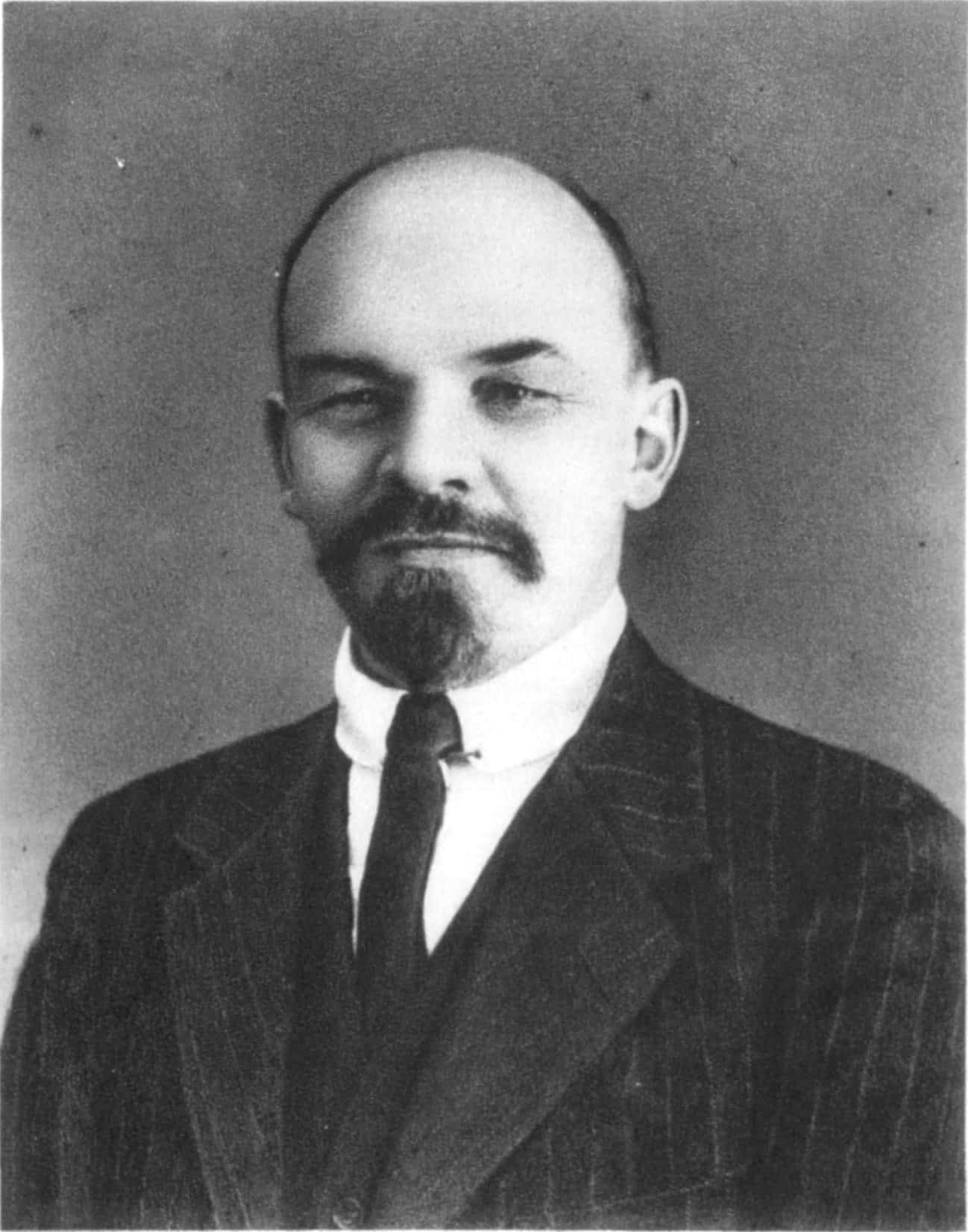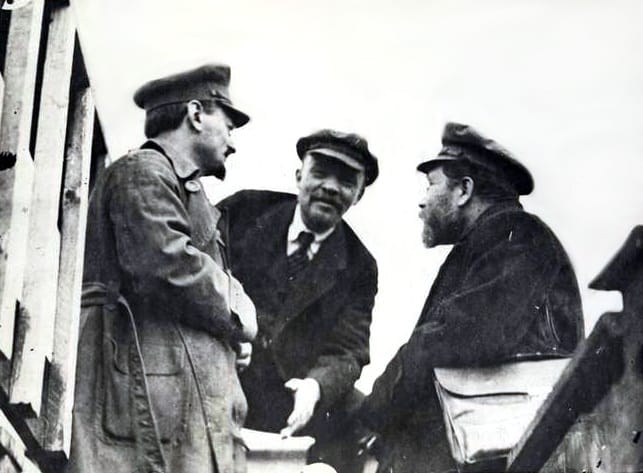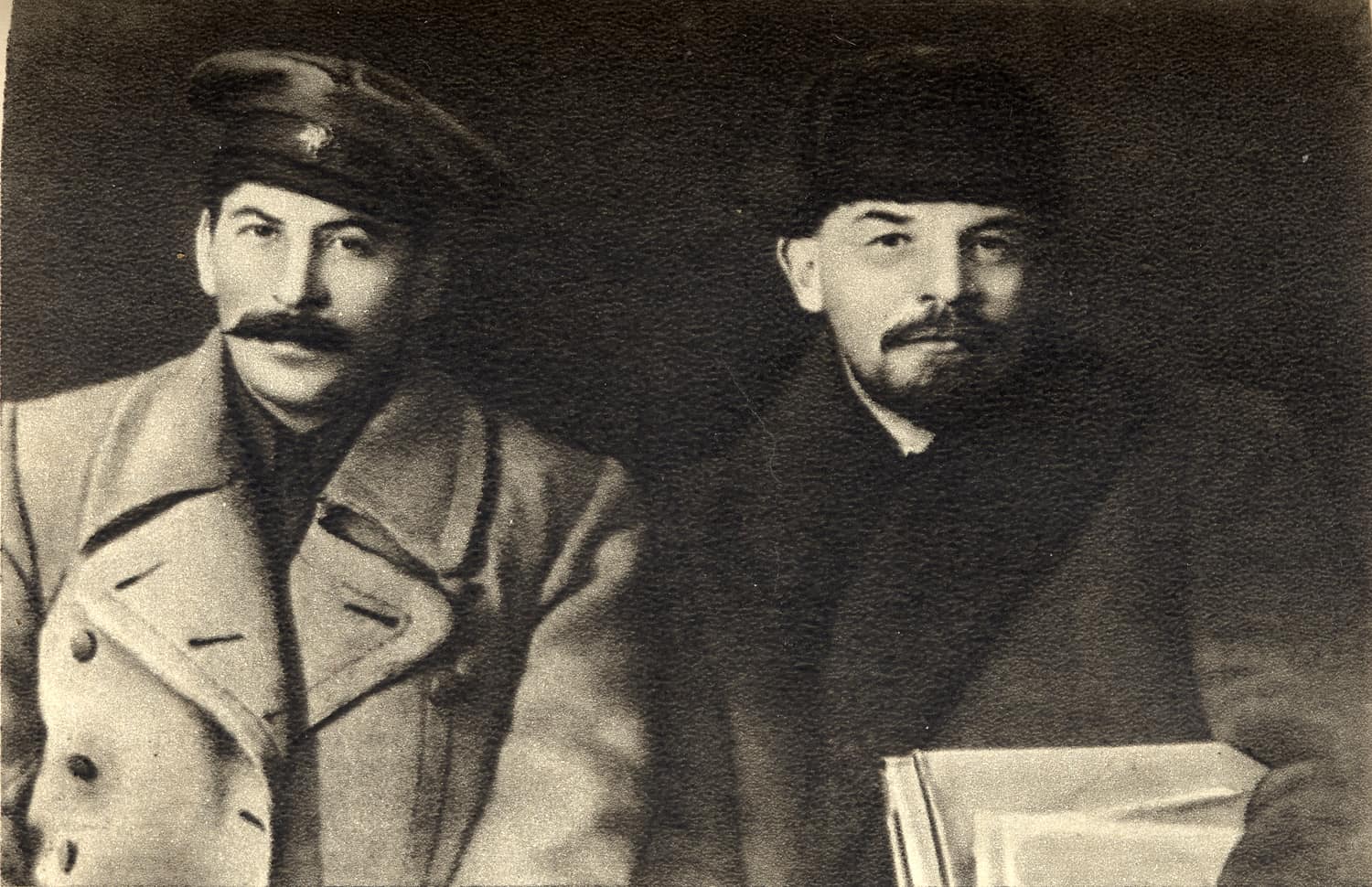Key Facts & Summary
- Since his youth, Lenin was interested in politics and was especially fascinated by Marx and Engels’ ideologies.
- He became the founder and leader of the Russian Communist Party.
- During the Second Congress of the Russian Social-Democratic Workers Party the party split between Mensheviks and Bolsheviks. Lenin joined the latter.
- Before he died, he wrote in his will that he did not want Stalin to succeed him. In fact, he desired Trotsky to take the lead.
Biography
Lenin is the pseudonym of Vladimir Il’ič Ul’janov. He was born into a middle-class family in Simbirsk – a small town on the Volga River – on April 22, 1870. His father directed public school and was awarded by the Tsar for his service, whereas his mother was a cultured musician (Collier’s Encyclopedia). Lenin was very fond of his brother Alexander who was three years older than him. In his early childhood, he immediately demonstrated that he was a good student. Although his father suddenly died in 1886, Lenin and his family were able to live a dignified life thanks to his father’s pension and the income from a property they owned (Collier’s Encyclopedia).
In 1887, another tragedy hit the seventeen year old Lenin: his brother Alexander (who at the time was studying at the University of St. Petersburg) was arrested because of his adherence to a revolutionary party and was hanged two months later with the accusation of wanting to harm the Tsar Alexander III (Collier’s Encyclopedia).
In 1887, Lenin started attending the University of Kazan, and was expelled the same year for taking part in a political manifestation. Moreover, he had been obliged by the government to stay in a town nearing Kazan. He lived there until 1888 with some friends and family, until he moved to a city called Samara. Here, he dedicated himself to various studies including law, Russian economics, and languages such as French, English, Italian, Polish, Swedish, and above all German (which allowed him to read Marx and Engels) (Collier’s Encyclopedia).
In 1893 he moved to St. Petersburg where he became a ‘professional revolutionary’ and despite the beliefs of his opponents – the People’s Party – that consisted in the view that Russia would ‘remain an agricultural country’, Lenin started developing his own ideology and wrote: ‘the Russian worker, rising the top of all democratic elements will overthrow absolutism and will lead the Russian proletariat (side by side with the proletariat of other countries) by a direct road of open struggle toward the victorious communist revolution’ (Collier’s Encyclopedia). Lenin’s objective was that of promoting Marx’ word. It is only after recovering from a pneumonia which hit him in 1885 (and which almost killed him), that he travelled for four months across Europe (specifically Switzerland, Paris and Berlin), where he met other important revolutionaries of that era.
Once he returned to St. Petersburg, Lenin founded The Union for the Liberation of the Working Class, i.e. an underground revolutionary group which shared Marxist ideologies. It is in this group that Lenin met and collaborated with his future wife, Nadezhda Konstantinovna Krupskaya (Collier’s Encyclopedia).
However, his political activity got him once again into trouble: he was arrested in the same year, and imprisoned for fourteen months. During this time, Lenin dedicated himself to the reading of revolutionary writers, the writing of his book The Development of Capitalism in Russia, and the drafting of his ‘party program’ (Collier’s Encyclopedia). During his exile in Siberia from 1897 – 1900, Lenin ‘received books, magazines, pamphlets, and newspapers, and he maintained a voluminous correspondence with his family, friends, and fellow revolutionaries’ (Collier’s Encyclopedia). According to his wife Nadezhda – which was also exiled to Siberia until 1901 – for Lenin ‘the years of exile were not bad [since they] were years of serious study’ (Collier’s Encyclopedia; citing Krupskaya).
Once he was out of exile, Lenin moved to Munich where at the end 1900 he published two magazines: the Iskra (‘The Spark”) and the Zarya (“Dawn”). These magazines were able to make it into Russia, where they were distributed illegally.
In 1903, following the Second Congress of the Russian Social-Democratic Workers Party, Lenin witnessed the party splitting between Bolshevik (which he led), and the Menshevik (to whom he lost his magazine Iskra).
However, between 1905 and 1912 he launched other four papers: V Peyod (‘Forward’), Novaya Zhizn (‘New Life), The Proletarian, and Pravda (which was directed by Stalin in 1917) (Collier’s Encyclopedia).
The last years of Lenin’s life were dominated by strokes. In fact, his first stroke occurred in May 1922, and although he was able to return to work as soon as he recovered, by December of the same year he experienced another stroke which ‘paralysed the right side of his body’ (Collier’s Encyclopedia). In March 1923, a third stroke caused him to lose the ability to speak, and on January 21, 1924, Lenin died. His body was embalmed and currently rests in a mausoleum (Collier’s Encyclopedia).
Lenin’s Ideology
Before delving into Lenin’s ideology, it is necessary to understand the position that Tsar Nicholas II held within Russia. Being Tsar signified holding the absolute power in the Russian Empire.
Lenin took part in the revolution that overthrew the government of Tsar Nicholas II (1917) and founded the Soviet Union. During the reign of the Tsar, the Russians not only were obliged to ‘toil’ for over eleven hours per day, but their salary was also the lowest in Europe (Ted-ed 2014). When unarmed workers protested against their exploitation within factories, the Tsar’s militia fired and killed them.
Later on some reforms were introduced, including the representation of political parties and an elected assembly called the Duma. However, these new measures were useless since (I) the Tsar could dissolve the Duma at any time, and (II) the Tsar still held absolute power.
In the late XIX century Russia started to become more industrialised, and Karl Marx’ theories spread amongst the intellectual of all Europe and Russia. Marx (along with Engels) is regarded as the founder of modern Communism, which claimed that the means of productions such as factories should be owned by everyone rather than by a single individual. Moreover, Marxism did not believe that social classes shows exists, and that therefore also the monarchy and the clergy should be abolished, while the economy should be controlled by the central government.
Once the Bolsheviks gained power, the Tzar and his family (including his children) were executed without any trial, however, they justified this action by claiming the necessity to eliminate any of the Tzar’s heirs since foreign imperialists that were trying to restore the Tzar, would have given the command to any of his descendants (Ted-ed 2014). In such a chase, the people’s efforts would have been in vane, and everything would have gone back to its previous state.
In essence, Lenin wanted to destroy the current society he was living in, which consisted in the extreme exploitation of the Russian people: most of the population was ‘peasants…[and] some European Marxists viewed Russia as the backward stepchild of Europe which would be one of the last countries to have a socialist revolution’ (Fleming 1989).
In Russia 80% of the population was peasant and according to Lenin, they should play a major role in the government’s conduction: therefore, it was necessary to ‘take political power, replace the government of the capitalist class with the rule of the working people’ (Fleming 1989). However, not everyone was in favour of Lenin’s ideology: in fact some Marxist rejected this idea wholeheartedly and believed that if the ‘peasants’ took part in government affairs, then ‘petty bourgeois ideology’ would infiltrate the system (Fleming 1989).
To summarise, Lenin’s priority were:
- ensuring democracy to all the Russian people (including the working class)
- ending the ‘oppression of minority nationalities and women’ (Flemieng 1989)
- ensure all citizens a dignified life that excluded ‘exploitation’ (Fleming 1989)
- tackling capitalism by breaking down the system, i.e. confiscating the large landowner’s lands and ‘abolish[ing] private property in order to redistribute them to peasants (Fleming 1989)
- Lenin collectivised ‘all factories, mines and transports’ in 1918 (Fleming 1989)
- Councils that defended the worker’s right and interests were set up
Lenin’s ambition was that of providing the Russian people with equal opportunities. In fact, he believed that no social class should be more privileged than another. In fact, in the April Theses (1917) published in his magazine Pravda, he stated: ‘the salaries of all officials, all of whom are elective and displaceable at any time, [should] not exceed the average wage of a competent worker’ (Lenin 1917).
Lenin, Trotsky, and Stalin
When Lenin met Trotsky, he was fascinated by the knowledge he held and decided to give him a job on Iskra’s editorial board by writing political articles.
Iskra’s main goal was that of calling a Send Congress of the Russian Social-Democratic Workers party in order to restructure it. However, Trotsky did not completely agree with Lenin’s politics and believed he would exert dictatorial tendencies that would impose strict policies that would instil fear in who dared opposing him. This difference in ideology is the reason why the Congress resulted in the division between Bolsheviks and Mensheviks. The Mensheviks – of which Trotsky was a part of – believed that the Russians did not need a leader, but a someone that would guide them. Therefore, one the one hand Trotsky exhorted the workers to put their tools down, whereas Lenin encouraged a violent and bloody revolt.
Bibliography
[1.] Fleming, R. (1989). Lenin’s Conception of Socialism: Learning from the Early experiences of the World’s first socialist revolution. Forward. 9 (1)
[2.] Lenin, V. (1917). The Task of the Proletariat in the Present Revolution [a.k.a. The April Thesis]. [online] Marxists. Available from: https://www.marxists.org/archive/lenin/works/1917/apr/04.htm
[3.] Ted-ed (2014). History vs. Vladimir Lenin – Alex Gendler. [online] Youtube. Available from: https://www.youtube.com/watch?v=9N8hsXQapjY
Image sources
[1.] https://cdn2.picryl.com/photo/1919/12/31/lenin-with-comrades-at-a-may-day-rally-in-red-square-may-1919-1024.jpg
[2.] https://upload.wikimedia.org/wikipedia/commons/6/65/Lenin_in_Switzerland.jpg
[3.] https://upload.wikimedia.org/wikipedia/commons/f/ff/Lenin_1919-03-18.jpg
[4.] https://www.marxist.com/images/cache/45ec0f31d8c60fd9eeee65a2933a7ba6_w1000_h864.jpg
[5.] https://c1.staticflickr.com/8/7009/6438998007_0c3a71f45d_b.jpg
[6.] https://upload.wikimedia.org/wikipedia/commons/0/08/Vladimir_Lenin_and_Joseph_Stalin%2C_1919.jpg




